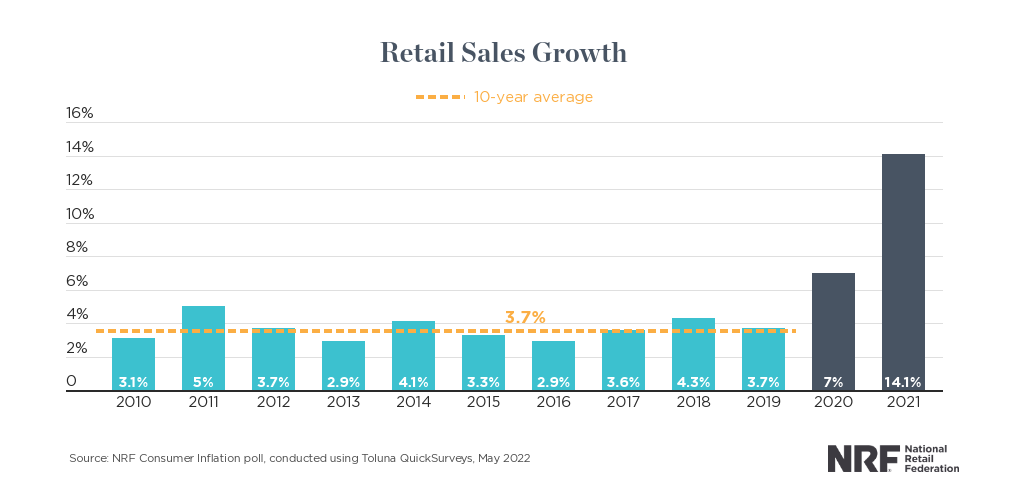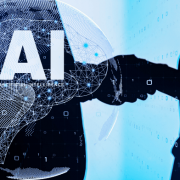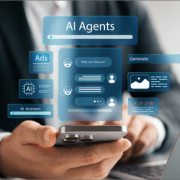Post-pandemic, the increase in consumer demand presents once-in-a-generation opportunities to retail industry players. In 2021, retail sales1 increased 14.1%—the highest growth in the past two decades. US consumers spent more than $1 trillion on retail products as compared to 2020. And this increase seems to be continuing.

Capitalizing on Top Retail Trends – The D&A Scope
Leveraging post-pandemic changes in consumer behavior and expectations requires retailers to innovate data-powered product and processes. Here we present a roundup of retail industry trends and how data and analytics (D&A) initiatives can support them.
Invest in Retail AI Solutions to Improve your Digital Presence
A strong online presence is essential today, whether a business is service-based, brick-and-mortar, or strictly ecommerce. A 2020 eMarketer study2 reports that we spend nearly eight hours each day doing digital activities. Today out of the total retail sales, online retail and ecommerce accounts for about 19% while cutting-edge technology further accelerates online sales.
Retail AI solutions are redefining face-to-face communication and selling. The future for ecommerce looks increasingly more promising as multiple players enter the space and expand their global presence. And compared to traditional retail businesses, it’s easier for companies to scale online while realizing low associated costs.
From a consumer angle, 69% of new buyers came from Asia Pacific in 2020. One US fashion retailer sought to expand its business there, as well as in Europe and the Middle East. Infocepts helped it elevate eCommerce sales with a cloud-native, sales intelligence platform it then rolled out in 53 countries. Providing real-time insights to all its sales associates, the company’s new, data-driven solution helped it generate an additional revenue stream of $50 million plus.
Provide Omni-Channel Experience by Lowering Time-to-Insights
Customer behavior is changing, with their expectations being higher than ever. Easy access to information, multiple buying options, and rapid technological advancements provide them with more ways to shop online. An omni-channel approach focuses on improving the consumer experience while engaging them via more platform options. Infocepts has helped many companies worldwide to implement D&A solutions based on modern retail business, selling, and product strategies. These include:
- BOPIS (buy online, pickup in store)
- BOSS (buy online, ship to store)
- View in your room (with the help of virtual reality apps)
- Try before you buy
While consumers shop from the comfort of their homes, a unified, omnichannel experience can come as close as possible to that of a brick-and-mortar store. It all starts with your enterprise having a single source of data. Such coordinated handling of data, insights, and the market scenario enables it to quickly respond to changing customer behavior.
Wrestling with its legacy data system and lack of real-time analytics, one retailer was challenged while executing such a strategy. Upon engaging Infocepts, we rejuvenated its omnichannel operations with real-time data integration by way of our reusable Real-Time Data Streamer (RTDS) accelerator, which fast-tracks real-time intelligence for clients. Our solution quickly optimized inventory, shipping, order fulfilment, and workforce management for the client’s distribution center, reducing its costs by $3.6 million in three years.
Navigate Workforce Shortage Proactively with Best-in-Class Analytics
COVID-19 sent massive disruptions through global markets and workforces, with 87% of retailers reporting recruiting difficulties in 2021. The combination of rising customer expectations, heavier work demands on associates, and the new ways of working post-pandemic have changed how retailers are able to fulfill their staffing needs. Data and analytics can address such challenges by –
- Analyzing historical workforce data
- Predicting future needs to better match customer demand with real-time decisions
Another of our clients had issues with scheduling, staffing, and payroll management in its global retail locations due to limited visibility across workforce management data points. We helped the client improve efficiency and productivity by integrating its workforce management with store operations data. This helped optimize daily operations, and a variety of metrics and dashboards improved staffing, scheduling, and payroll management across its worldwide locations.
Optimise Inventory Planning with Real-Time Analytics
Post-pandemic, big retailers rushed to build up inventories amidst soaring consumer demand and supply chain bottlenecks—in some cases going so far as to rent their own cargo ships. Shortly thereafter companies tried selling off excess inventory. In the US, inventories rose $44.8 billion for companies on S&P consumer indexes; retailers were paying more for storage while prices of goods dropped.
Today, real-time, data-driven decisions enable companies to revamp their supply chain by achieving speed and accuracy in inventory management. During changing customer demand and other external trade factors, Infocepts helped another retailer exercise real-time decision making for inventory planning. Including multiple leading and lagging indicators, our solution integrated real-time data along with consumer behavior to predict demand.
Be Agile with Data-driven Intelligence at Every Step
Data-driven decision making is essential for growth and strategic planning in any organization. But simply using data is not enough. Agility—the ability to quickly react amidst constant change within your decision-making framework—is also critical for success.
For example, Amazon Go (still in beta), uses 3D camera technology and RFID3 to automatically detect which products customers are picking up, permitting them to leave the store without a formal checkout process.
The following technology innovations are already in use (or in beta):
- Cameras and Wi-Fi measure the flow of instore traffic, thus helping retailers schedule their workforce.
- Augmented reality (AR)/virtual reality (VR) coupled with eye tracking can predict how customers react to retail displays. This helps to position products better so as to increase sales.
- AI for retail operations includes customer analysis, demand prediction, inventory optimization, and competitive research to help companies stay ahead through data-driven decision making.
- Robots as sales assistants, drone deliveries, smart mirrors, devices with voice-based search, and digital beacons combine to provide cost savings while enhancing the shopping experience.
Armed with real-time data analytics, retailers will be able to act more quickly, test multiple concepts, and constantly improve sales and customer experience with agility.
Infocepts recently collaborated with Neumont College of Computer Science in Salt Lake City to implement Power BI reporting and its functionalities using Microsoft’s HoloLens 2. It lets users see product data in the 3D HoloLens world. Read about it here: Rethink Retail Analytics with Real Time Data.
Promote Interoperability with Evolving Industry Standards
For systems to be interoperable, they must be able to exchange data and present it in a way that is easily understood by users. Data interoperability is extremely important for growth in retail. The fusion of multiple data points offers huge value in operational insights and the ability to create collaborative workflows to improve process efficiencies. Organizations that use data to accelerate growth realize a faster ROI from multiple investment areas within their business.
A well-known global research firm offers a comprehensive view of consumers and the market through analytics to hundreds of its client retailers and packaged-goods manufacturers. But due to multiple legacy and out-of-the-box reporting tools within its infrastructure, its challenge was to streamline insights to provide a consistent user experience. Infocepts helped it create a unified portal to access 200+ analytical insights across 30+ applications.
The centralized portal enhanced data interoperability to improve overall effectiveness of its analytics ecosystem. After just three months, the company realized 50% higher engagements and interactions with data insights.
To remain competitive and excel, today’s retailers require help from strategic D&A experts. Infocepts helps them establish data interoperability, resulting in a single source of truth for organizational decision making.
Take Advantage of New-Age Retail Trends
The post-pandemic retail surge and rush to find innovative ways to better manage customer expectations will continue for many more years. Retailers who use data assets to transform their products, services, and business model will thrive. In order to accomplish this, you must promote a culture of data-driven decision making, prioritize D&A investments, and closely monitor your ROI. Partnering with Infocepts—a specialized D&A consultant that is highly rated by industry leaders, has deep technological expertise, and comes with a broad spectrum of reusable solutions—can prepare you to address your today’s challenges while preparing you for tomorrow’s.
Want to learn more? Talk to us to accelerate your retail transformation with a data-driven strategy and cutting edge solutions to improve your business outcomes and customer experience.
References:
Recent Blogs

Bots to Brains: How Agentic AI is Changing the Game
July 8, 2025

The Future of Supply Chains Is AI-Driven—Is Your Business Ready to Embrace the Change?
July 2, 2025

What Retail Media Can Learn from Instacart’s AI Strategy
June 24, 2025

Beyond Chatbots: How Agentic AI Is Automating High-Stakes Business Decisions
June 11, 2025


